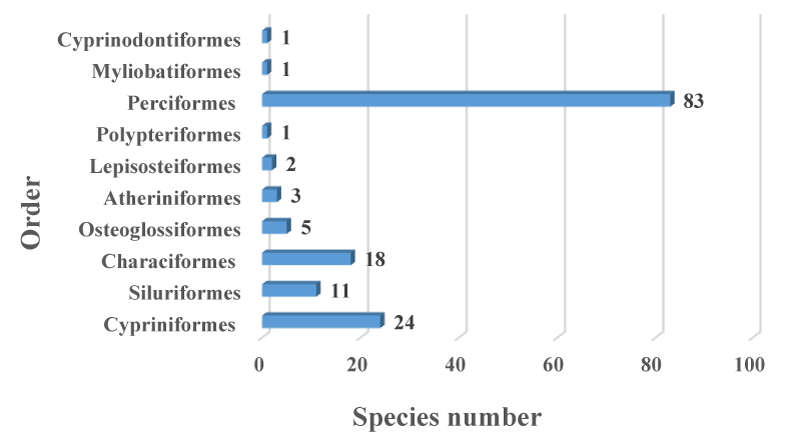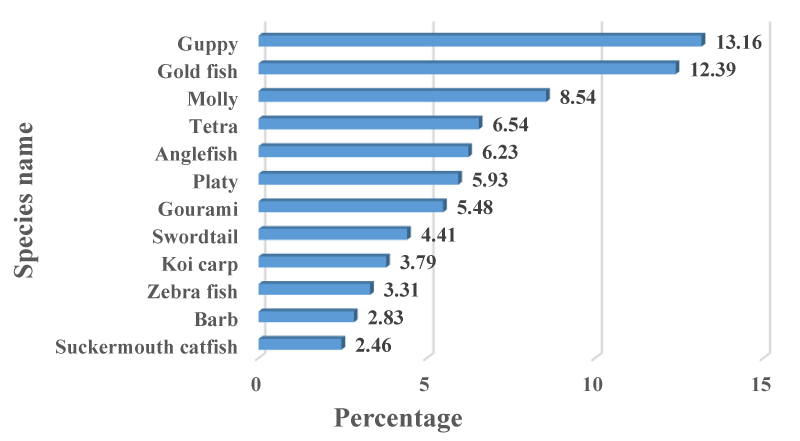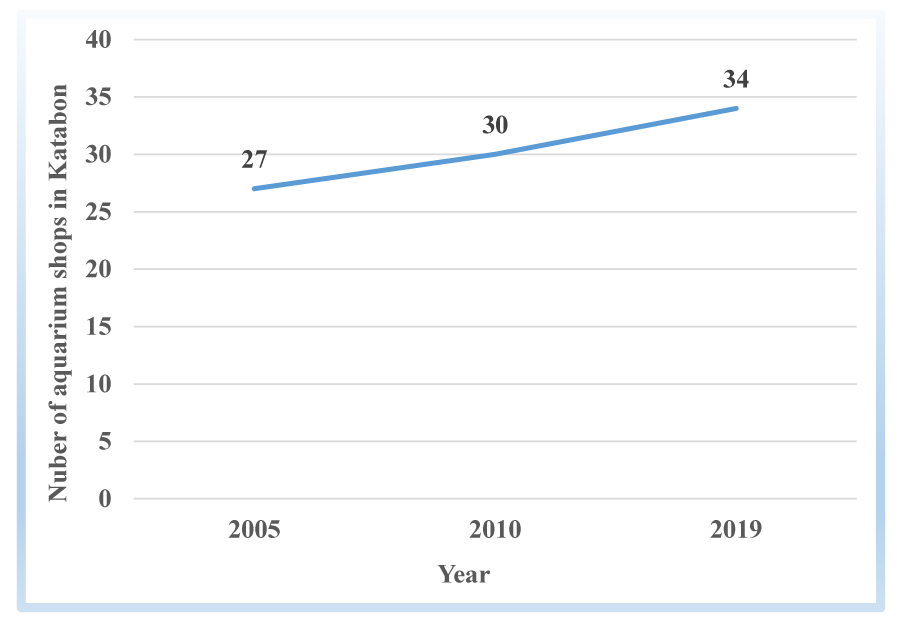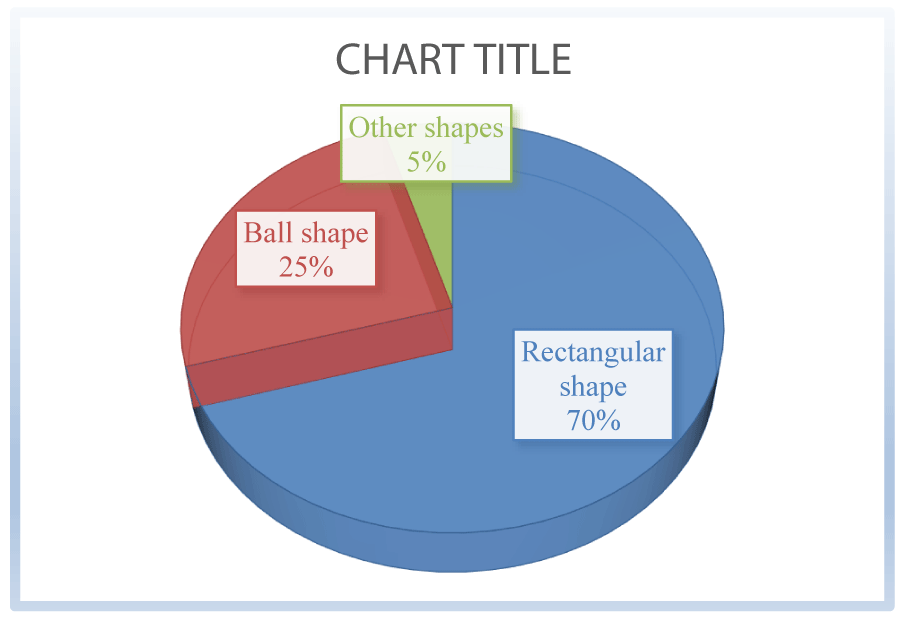International Journal of Aquaculture and Fishery Sciences
Ornamental aquarium organisms trade in Bangladesh
Noor-E-Ishrak Hossain1* and ABM Mohsin2
2Department of Fisheries, University of Rajshahi, Rajshahi-6205, Bangladesh
Cite this as
Hossain NEI, Mohsin ABM (2022) Ornamental aquarium organisms trade in Bangladesh. Int J Aquac Fish Sci 8(1): 010-024. DOI: 10.17352/2455-8400.000074Copyright License
© 2022 Hossain NEI, et al. This is an open-access article distributed under the terms of the Creative Commons Attribution License, which permits unrestricted use, distribution, and reproduction in any medium, provided the original author and source are credited.The study was conducted in Dhaka, Bangladesh, and was carried out for twelve (12) months from March 2018 to February 2019 with a view to represent the trading diagram of ornamental fish in Bangladesh. During the current study 270 varieties (230 freshwater, 36 marine, and 4 brackish water) belong to 149 species (109 freshwater 73%, 36 marines 24%, and 4 brackish water 3%) of 38 families under 10 orders and 6 crossbreeds’ varieties were recorded. Considering the number of species maximum 83 (55.70%) was found under the order Perciformes followed by Cypriniformes 24 (16.10%), Characiformes 18 (12.08%), Siluriformes 11 (7.38%), Osteoglossiformes 05 (3.35%), Atheriniformes 03 (2.01%), Lepisosteiformes 02 (1.34%), Polypteriformes 01 (0.6%), Myliobatiformes 01 (0.67%) and Cyprinodontiformes 01 (0.67%). The top five popular species were guppy (13.16%) followed by goldfish (12.39%), molly (8.54%), angelfish (6.23%), platy (5.93%). Most of the ornamental fish species were imported by importers from Thailand, Singapore, Indonesia, India, Malaysia, and Japan on the basis of demand. Then the imported shipment of aquarium fish and fish products was distributed among Dhaka Katabon fish shops, wholesalers, and retailers, according to their given order. After that, these were again distributed locally, to aquarium shops, breeders, ornamental fish farms all over the country. General customers and hobbyists purchase ornamental fish and aquarium products from local aquarium shops and businesses. The increasing tendency of the number of fish species was 5.96 times in the last 15 years and 3.31 times in the last 10 years. Local farms and aquarists’ breeders bred 76 varieties under 23 species due to its high demand and profitability. Pricing varied on varieties, species, size, and breeding status (local or abroad), availability and ranged from BDT 40.00-80,000.00 per pair. Considering the findings, aquarium fisheries is highly profitable at present and it will be a potential sector in Bangladesh.
Introduction
Aquarium fishes are attractive colorful fishes of various characteristics, which are kept as pets in the confined space of an aquarium or a garden pool for fun and fancy [1]. These living jewels need not always have bright colors; as sometimes their peculiar characteristics such as body color, morphology, mode of taking food, etc. may also add to their attractiveness [2].
An aquarium is an enclosed body of water containing a mixture of selected and unselected captive living aquatic organism which is essentially unstable and to obtain stability must be carefully designed and managed [3]. Aquarium keeping is amongst the most popular of hobbies with millions of enthusiasts worldwide [4]. It was projected that 150 million ornamental fish both marine and freshwater were sold each year worldwide and the trade and its associated aquarium accessories were worth over US$7 billion annually, in the late 1980s [5].
Since 1985 the value of international trade in exports of ornamentals has increased at an average growth rate of approximately 14 percent per year [6]. More than 100 countries are involved in the ornamental fish trade and approximately one billion fish have moved annually between the trading blocks [7].
[8]. Reported that two common ideas of pet business in ornamental fisher are-either breeding fish or starting an aquarium maintenance service. Globally ornamental fish keeping treats as an industry due to its high market demand and profitability as well as it is a hobby that has been rated as the second most popular and most popular type of pet in the industrialized country [9]. Pet industry surveys have estimated the aquarium industry worth over $1,000 million USD [10]. Singapore is currently the main exporter of ornamentals to the world [11]. The United States (US) is the single largest importer of ornamental fish in the world [12]. More recently, it was estimated that 1,471 marine ornamental fish [13]. And more than 4,000 species of ornamental freshwater fish were traded globally each year [14]. Both freshwater and marine water fish species are popular among hobbyists. But statistically, from commercial perspective freshwater species dominate 90-96% and are produced in commercial aquaculture facilities [10,15]. Although exact figures on the value and trade of the ornamental fish industry do not exist, the value of ornamental fish and invertebrates imported into different countries worldwide is approximately $278 million US dollars [12].
The approximate global import value of aquarium fishes is US$ 321 million [16]. And among them, only US$ 21-48 million is belong to the marine aquarium fish trade [17]. The business of ornamental fish is now very popular in many countries of the world and a rapidly growing venture in Bangladesh [18]. Nowadays farmers and investors are very much interested to move their business to more diversified fields such as crocodile culture, pearl culture, aquarium fish trades, etc. [19]. The study area was selected in Dhaka city because it is considered the hub of the aquarium fish trade in Bangladesh. The present study was conducted following some specific objectives- to know the types, price, popularity, and trade chain of ornamental aquarium species in Bangladesh. Knowing the ornamental organism’s business chain, which will help us to know the economic potential and contribution in Bangladesh.
Materials and methods
The study was conducted at Katabon aquarium fish market, Tajmahal Road, Mohammadpur, Hatipool road, and Kachukhet, Mirpur in Dhaka city for a period of twelve (12) months from March 2018 to February 2019. Frequent field visits were made during the study period to the study area for the collection of primary data. The primary data were collected by the survey which was divided into their sub-divisions such as eye observation, farm walk, and interview with the help of a questionnaire. Forty different aquarium shops and 40 respondents of aquarium shopkeepers, 20 respondents of aquarium hobbyists, and 5 respondents of aquarium fish breeders were interviewed during the survey.
Primary data, the identification of the fish species, and other aquarium organisms for creating the checklist were cross-checked with help of secondary data such as journals, books, authentic online databases, online ornamental fish shops, and other published documents. A taxonomic study was used to prepare the checklist of aquarium fish. The availability of ornamental aquarium fish was determined by counting the numbers of individual species and varieties. Numeric data were analyzed by using Microsoft Excel 2016.
Result and discussion
The present study consists of 270 aquarium fish varieties under 149 species which are belong to-115 genera, excluding 6 crossbreeds varieties under 1 species.
On the other hand, previous studies recorded the number of aquarium fish species were 78 varieties under 45 species, 41 genera and 2 cross-breeds by [18]. 25 species by [20]. In Dhaka Katabon, 26 species by [21]. In Dhaka katabon, 12 species by Mohsin, et al. [22]. In Rajshahi city, 22 species by Arif, et al. [23]. At Sylhet Sadar Upazila, 29 varieties by Alam, et al. [24]. In Barisal division and 30 species by [19]. In Khulna district. The number of aquarium fish species recorded in the present study is higher than in previous studies. Except for the present study, no marine and brackish water aquarium fish and other fisheries items were recorded in the previous studies Tables 1,2, Figure 1
During the study most popular and highly contributed species in the surveyed shops were guppy (13.16%) followed by goldfish (12.39%), molly (8.54%), tetra (6.54%), angelfish (6.23%), platy (5.93%), gourami (5.48%), swordtail (4.41%), koi carp (3.79%), zebrafish (3.31%), barb (2.83%), suckermouth catfish (2.46%). In a previous study according to consumer demand the most demandable aquarium fish species were goldfish, comet fish, koi carp, angle fish, platy, guppy, fighter fish, parrotfish, and discus by Faruk, et al. [21], Figure 2.
The number of aquarium fish species, aquarium shops, aquarium fish breeders, and hobbits has increased immensely due to the profitability for traders and acceptability by the aquarists.
During the study period, 149 aquarium fish species are recorded which is 5.96 times in the last 15 years [20]. (25 species) And 3.31 times in the last 10 years [18]. (45 species) (Figure 3).
During the study, it was recorded that 76 varieties of aquarium fish under 23 orders were bred by local aquarium breeders and farms (Figure 4).
On the other hand, according to Galib [18]. Artificial breeding techniques of at least 17 varieties of exotic ornamental fishes have been developed by amateur fish breeders. According to present findings, it is clearly indicated that the number of varieties as well species of native and non-native ornamental aquarium fish is highly increased rapidly.
Moreover, the diversity of the habitat and number of locally bred non-native species are raised as well. It is concluded that the native and non-native ornamental aquarium fish breeding and keeping practice (hobby and business) is becoming a potential sector in Bangladesh.
Trade chain of aquarium fish and aquarium other fisheries items
During the present study, it was observed that people of different categories were connected to each other in the aquarium fish marketing channel in Bangladesh. Detailed information of import of exotic was not maintained systematically in Bangladesh [19,20].
In the present study, the access pathway, the distribution, and the marketing channel of aquarium fishes and other fisheries organisms are shown in (Figure 5). It was found that most of the imported aquarium fish and other fisheries items were introduced from Thailand, Singapore, Indonesia, India, Malaysia, Japan, etc.
The goldfish was introduced from Pakistan former West Pakistan in 1953 [25]. And the tiger shovelnose catfish was introduced from Australia in 2009. Mainly aquarium fishes and other fisheries organisms were imported by aquarium fish importers of Bangladesh, located in Katabon area of Dhaka city [26-31].
Aquarist sometimes personally import their products but it is very rare. Various online agencies are importing aquarium items and trading through online platforms such as websites, Facebook. Breeding techniques of many aquarium fishes and other fisheries organisms are discovered by local breeders online.
Local breeding organisms are also distributed through Katabon and local aquarium shops. Aquarium fish farms are commercially breeding and cultivating aquarium fishes and other fisheries organisms and creating new possibilities in the aquarium business.
(Kohls and Uhl, 1980) stated that the marketing channel may be short or long for a particular commodity depending on the quality of the marketed products, nature, and size of the consumers and producers.
During the study, it was found that the price of aquarium fish is much higher than food fish. The proportion between the space required for aquarium fishes and culture fishes is very significant. Aquarium fishes need a little amount of space to maintain, breed and the management cost is very low compared to the price.
The top 3 highly-priced aquarium fishes were found as- Golden Arowana (20000-80000 BDT/pair), Black Arowana (18000-45000 BDT/pair), and Ocellate River Stingray (15000-25000 BDT/pair) (Table 3)
[18]. Recorded silver Arowana as the most expensive species (30000 BDT/pair), Koi carp (12000 BDT/pair), and Tiger shovelnose (4000 BDT/pair). Rahman, et al. [19]. Found red parrot as the most expensive species (1000-1500 BDT/pair), in their study followed by discus (800-1000 BDT/pair) and oscar (400-600 BDT/pair). Arif, et al. [23]. Mentioned discus as the most expensive species (1500 BDT/pair), parrotfish (1000 BDT/pair), and oscar (650 BDT/pair) Table 4.
During the study, it was recorded that 76 varieties of aquarium fish under 23 orders were bred by local aquarium breeders and farms. Artificial breeding techniques of at least 17 varieties of exotic ornamental fishes have been developed by amateur fish breeders [18].
Mostafizur, et al. [19]. Reported that 12 shops and 7 breeders have been found in the Khulna district where 29 different aquarium fish species were marketed of which 12 species were bred for fry production Figure 6.
Rahman [20]. Recorded 25 aquarium shops in the Katabon pet market and in the present study the number had increased to 34 due to the popularity and demand of the business. The majority of the shops of aquarium fish are located in Dhaka city [18].
Another study [18]. Stated that there are only 2 shops in Rajshahi city, while 12 shops are found in Khulna city.
[18]. Found that at least 30 aquarium shops are available in the Katabon market of Dhaka city where all kinds of aquarium products can be found.
Aquarium fish price depends on varieties, species, size, and breeding status (local or imported). Considering the price of cheap species, it can be said that aquarium hobby is not only for elite society people but also for common people as well. Due to the demand and profitability, this business spread drastically. So, aquarium fishes and other fisheries items are and will be of great potential judging by the circumstance in our country.
Aquarium and aquarium accessories
Aquarium accessories also play a vital role in the trade. Beyond sales of the aquarium, air pumps, food, medications and other supplies, the primary product of the aquarium industry is fish [7]. Katabon market, the most common and popular market in Dhaka city for aquariums and other aquarium products like aquarium fishes, aquarium foods, chemicals, toys, plants, etc.
Aquariums
There are various types of aquariums according to their shape and size. Some are suitable for fish keeping, breeding and others are for ornamentation. Price differs due to the size, shape as well as thickness of glass or aquarium building material Tables 5,6.
Aquarium decoration toys are mainly used to enhance the beauty and appearance of an aquarium. Such as plastic plants, artificial streams, water flow, etc. Aquarists can add various decorative stuff which can be beneficial for fish as well Figure 7.
During the study it was found that 70% of hobbyists were having rectangular shape aquariums, 25% ball shape and 5% were having other shapes (hexagonal, cube). Mohsin, et al. [22]. Described preferences for rectangular shape 69% and ball shape jar 29% in Rajshahi city, Bangladesh. Arif, et al. [23]. Found that 80% of the hobbyists were having rectangular shape aquariums and 20% had round shape aquariums in Sylhet Sadar Upazila, Bangladesh.
Foods used in aquarium
On the basis of the diet, there are different types of aquarium fishes having different preferable aquarium fish food. Some species are carnivores, some are herbivores, and others other omnivores. According to the different life stages also varies as well Table 7.
Turtle food
Table 8.
Aquarium air pumps or aerators
Aquarium air pumps or aerators’ main purpose is to produce Oxygen by creating water flow. It is vital to have a sufficient amount of oxygen in the aquarium water to keep fish healthy and alive. Numerous types of aerators were observed during the study Table 9.
Aquarium filters and gravels
Aquarium filters are used to keep the aquarium water clean by removing pollutants (fish waste, degraded food, ammonia, and toxic materials). There were various types of gravels found among the most commonly used were black and white crust gravels. Gravel is mainly used for the sedimentation of water products and keeps the water clean. Gravel prices generally range from 20-40 (BDT/kg) Table 10.
Aquarium water heaters
Aquarium heaters are used to maintain the optimum water temperature in the aquarium. Especially in the winter water temperature drops to a critical level which is detrimental for fish health and may lead them to death. Popular heaters are used by the aquarists in Bangladesh Table 11.
Aquarium medicines
Aquarium medicines are used for the treatment of contaminated organisms and aquarium water. Some medicines were listed during the study period such as Table 12.
Economic importance of aquarium fishes
During the study, it was found that the price of aquarium fish is much higher than culture fish which is taken as food. The proportion between the space required for aquarium fishes and culture fishes is very significant. Aquarium fishes need a little amount of space to maintain, breed and the management cost is very low compared to the price.
On the other hand, culture fish species need a lot of space, maintenance costs, and comparing to the price. For example, the price of Thai pangasius (Pangasius hypophthalmus) is 90-120 BDT/kg but the same species are known as tiger sharks keep in the aquarium an 80-360 per pair which is a much higher price than its cultural value.
The top 3 highly-priced aquarium fishes were found as- Golden Arowana (20000-80000 BDT/pair), Black Arowana (18000-45000 BDT/pair), and Ocellate River Stingray (15000-25000 BDT/pair) Table 13.
[18]. Recorded silver Arowana as the most expensive species (30000 BDT/pair), Koi carp (12000 BDT/pair), and Tiger shovelnose (4000 BDT/pair).
Rahman, et al. [19]. Found red parrot as the most expensive species (1000-1500 BDT/pair), in their study followed by discus (800-1000 BDT/pair) and oscar (400-600 BDT/pair).
Arif, et al. [23]. Mentioned discus as the most expensive species (1500 BDT/pair), parrotfish (1000 BDT/pair), and oscar (650 BDT/pair) Table 14.
Conclusion
Considering the present study, it was very much clear that the current situation of the aquarium business had become a potential commercial sector in our country. Connecting the past and present studies observation it can be stated that the popularity, diversity of aquarium fisheries products, and the number of shops had drastically increased. In the past, most of the aquarium fishes were imported from foreign countries but according to the current study 23 species under 76 varieties were locally bred by our hatcheries and local breeders. Marketing had become more flexible; customers can purchase aquarium fish and other products by ordering them in online shops as well as by going to the shops. Aquarium fish cost, management, and space are much less than culture fish. Due to the immense potentiality, the sector is not contributing to national GDP. If we raise our concern and realize the value of the sector and properly nurture it will become one of the remarkable foreign currency income sources in the near future.
I would like to express my special thanks of gratitude to my honorable teacher Professor ABM Mohsin for his proper guideline and support. I would also like to extend my gratitude to all the staff Department of fisheries, University of Rajshahi.
- Chakravartty P, Chakravartty M, Sharma S (2012) A Survey on the Fish Diversity with Special Reference to the Classified Ornamental Fishes and their Prospects in the Kapla Beel of Barpeta District. The Sci Probe 1: 12-21.Link: https://bit.ly/3CpyOme
- Selvarasu A, Sankaran A (2010) Marketing Strategies Vis-a-Vis Consumer Preference for Aquarium Business Service. Int J Latest Trends Fin Eco Sci 1: 23-29. Link: https://bit.ly/3KCGvZf
- Suxena A (2003) Aquarium management. Daya Publishing House. New Delhi. Link: https://bit.ly/3CFLmGl
- James DE (1981) Carolina’s freshwater aquarium handbook, Carolina biological supply company, Burlington, NC/Gladstone, OR 4.
- Andrews C (1990) The ornamental fish trade and fish conservation. J Fish Biology 37: 53-59. Link: https://bit.ly/3tGs8MC
- Bartley D (2000) Responsible Ornamental Fisheries. FAO Aquaculture Newsletter 10-14. Link: https://bit.ly/3w7zoUH
- Cheong L (1996) Overview of the current international trade in ornamental fish with special reference to Singapore. In: Revue Scientifique Et Technique. Preventing the Spread of Aquatic Animal Diseases. (Editor B. J. Hill, and T. Hastein) Rev Sci Tech 15: 445-481. https://bit.ly/3sYzWKp
- Clark D (2002) Aquarium maintance service who should start one aquarium fish magazine.
- Olivier K (2001) The ornamental fish market. FAO/Globefish Research Programme, United Nations Food and Agriculture Organization, Rome, Italy. 67. Link: https://bit.ly/3J0dFBE
- Cato JC, Brown CL (2003) Marine Ornamental Species: Collection, Culture, and Conservation. Ames, IA: Iowa State Press. Link: https://bit.ly/3vVG8Vk
- Chua FHC (1996) Aquaculture health management in Singapore. Current status and future directions. FAO Food and Agriculture Organization of the United Nations. Fisheries Technical Paper 115-126. Link: https://bit.ly/3HX19S2
- FAO (1996-2005) Food and Agriculture Organization. The numbers represent the average unit value of imports for 1994-2003. FAO Yearbooks 1996 to 2005, Fishery Statistics, Commodities Volumes 83-97. FAO:Rome, Italy.
- Wabnitz C, Taylor M, Green E, Razak T (2003) From Ocean to Aquarium. UNEP-WCMC, Cambridge, UK. Link: https://bit.ly/373piJJ
- Whittington RJJ, Chong R (2007) Global trade in ornamental fish from an Australian perspective: The case for revised import risk analysis and management strategies. Prev Vet Med 81: 92-116. Link: https://bit.ly/3JcqFUV
- Chapman FA (2000) Ornamental fish culture, freshwater. In: R.R. Stickney (ed), Encyclopedia of Aquaculture, 602-610. New York, NY: John Wiley & Sons, Inc.
- Dawes J (2001) International aquatic industry perspectives on ornamental fish conservation. In: Chao L.N., Petry P., Prang G., Sonneschien L. and Tlusty M. (eds.), Conservation and Management of Ornamental Fish Resources of the Rio Negro Basin, Amazonia, Brazil – Project Piaba. EDUA, Manaus, Brazil, 100-121.
- Wood E (2001) Collection of coral reef fish for aquaria: global trade, conservation issues and management strategies. UK: Marine Conservation Society, Ross-on-Wye, 80. Link: https://bit.ly/3tL3biO
- Galib SM, Mohsin ABM (2010) Exotic Ornamental Fishes of Bangladesh. Bangladesh J Prog Sci Tech 8: 255-258. Link: https://bit.ly/36bncHy
- Mostafizur MR, Rahman SM, Khairul MI, Rakibul HMI, Nazmul MA (2009) Aquarium business: A case study in Khulna district, Bangladesh. Bangladesh Research Publication J 2: 564-570. Link: https://bit.ly/3IXwoh4
- Rahman AKA (2005) Freshwater Fishes of Bangladesh, 2nd edition, Zoological Society of Bangladesh, Department of Zoology, University of Dhaka, Dhaka.Link: https://bit.ly/3Cz8LsL
- Faruk MAR, Hasan MM, Anka IZ, Parvin MK (2012) Trade and health issues of ornamental fishes in Bangladesh. BangladeshJ Progressive Sci Technology 10: 163-168.
- Mohsin ABM, Haque ME, Islam MN (2007) Status of aquarium fisheries of Rajshahi City. J Bio sci 15:169- 171. Link: https://bit.ly/3KxRoeP
- Arif ASM, Nusrat S, Uddin M, Alam MT, Mia MR (2018) Hobbyist’s preferences and trends in aquarium fish business at Sylhet Sadar Upazila, Bangladesh. Int J Fisheries Aquatic Stud 6: 392-398. Link: https://bit.ly/3sYPUnW
- Alam M, Alam MJ, Pattadar SN, Karim MR, Mahmud S (2016) A trend of ornamental fish business in Barisal division, Bangladesh. International J Fisheries Aquatic Studies 4: 263-266. Link: https://bit.ly/3CrBFLf
- Ahmed N (1956) Transplantation of food fish in Pakistan. J sci 8.
- Akhter SM (1995) Echo aqua fisheries project. Dhaka, 1st edition. Aquarium guide 71.
- Galib SM, Imam MA, Rahman MA, Mohsin ABM, Fahad MFH, et al. (2013) A study on aquarium fish business in Jessore district, Bangladesh. Trends in Fisheries Research 2: 11-14. Link: https://bit.ly/3HPp1Hf
- Galib SM, Mohsin ABM (2011) Cultured and Ornamental Exotic Fishes of Bangladesh. LAP-Lambert Academic Publishing, Germany 167. Link: https://bit.ly/3KreIuD
- FAO (1994) Year Bool of Fishery Statistics, Vol. 75, 1992. Food and Agricultura Organisation of the United Nations. UNCTAD/GATT. Link: https://bit.ly/34rVDcr
- FAO (2013) Fisheries Department publications. FAO Fisheries and Aquaculture Department.
- Livengood EJ, Chapman FA (2009) The ornamental fish trade: An introduction with perspective for responsible aquarium cooperative extension service. Institute of food and agricultural science, University of Florida Gainesville FL 32611.

Article Alerts
Subscribe to our articles alerts and stay tuned.
 This work is licensed under a Creative Commons Attribution 4.0 International License.
This work is licensed under a Creative Commons Attribution 4.0 International License.






 Save to Mendeley
Save to Mendeley
